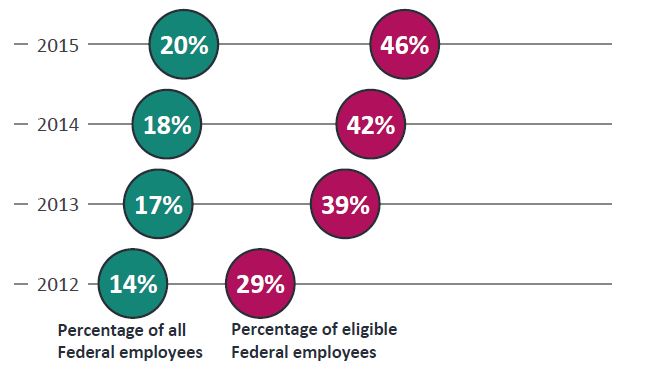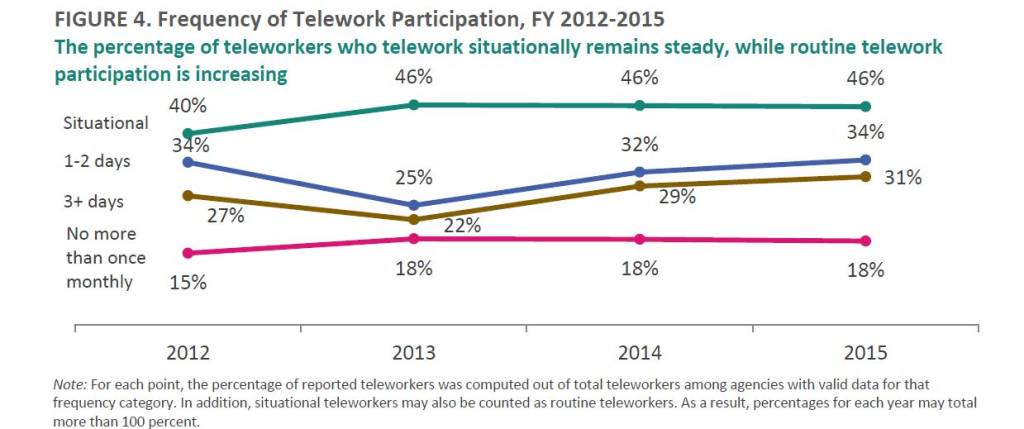
More feds teleworked in 2015 but more employees could be eligible, OPM says
The percentage of the federal workforce eligible to telework remained unchanged between fiscal 2014 and 2015, but more workers could be eligible to use the program,...
More federal employees teleworked in fiscal 2015, even as the number of workers eligible to use the program remained about the same over the past year.
Roughly 44 percent of the federal workforce was eligible to telework in 2015, while 46 of eligible workers used the program, according to the Office of Personnel Management’s latest report on the topic to Congress. The same percentage of federal employees was eligible to telework in 2014, while 42 percent of eligible workers actually used the program that year.
“This is a really important target area for agencies with an opportunity to improve participation rates,” Steve Shih, deputy associate manager for senior executive services and performance management at OPM, said during a Nov. 15 Chief Human Capital Officers meeting. “We really need to regularly assess and determine eligibility of positions for telework to be able to have a timely and accurate accounting and universe of all possible positions that are eligible for telework in order to make more progress on participation.”
Yet many agencies haven’t revisited their eligibility requirements since they first launched their telework programs, OPM said.
“As telework policies, capacities and norms have evolved, it is possible that some employees who were previously deemed ineligible to telework could now perform a portion of their work from an alternative location, particularly in emergency situations,” the report said.
About 20 percent of the total workforce used telework in 2015, compared to 18 percent of the workforce in 2014 and just 14 percent in 2012.

About 46 percent of eligible employees used telework on a situational basis, meaning they opted to work away from the office for agency closures or weather events, for example.
‘While situational telework increased and routine telework decreased between 2012 and 2013, for the period covered by this report, situational telework has remained stable and routine telework has increased slightly,” OPM said.
Roughly 34 percent of eligible employees used routine telework for one to two days during a two week period in 2015, while 31 percent teleworked for three or more days during a biweekly period. And 18 percent of eligible workers used telework no more than once every month, the report said.

Agencies are slowly beginning to improve their telework reporting, a challenge that the Government Accountability Office noted in August. Telework is saving some agencies millions of dollars, but too few departments document the data to support the benefits, GAO said.
The CHCO Council is expected to take up this topic at future meetings, Shih said.
Most agencies — 61 percent — rely on their time and attendance systems as the main data source to track telework, the report said. Some agencies, about 8 percent, use a combination of their time and attendance system and a customized tracking system.
About 31 percent of agencies manually review telework contracts to count participation rates, while 12 percent survey their employees about their use of the program.
These varied approaches to telework data collection is behind some of those challenges, Shih said.
“Often times the data is not necessarily as complete or timely or consistent as we’d like to see,” he said. “We’re taking efforts to shore that area up.”
Employees often misrepresent their own use of the telework program, the report said, and time sheets don’t often align with telework reporting requirements.
“Agencies must also make assumptions when calculating telework days,” OPM said in the report. For example, “some agencies count only employees who work full days from an alternative location, while others also count employees who work any part of the day from an alternative location.”
OPM later this summer acknowledged agencies’ challenges in reporting telework data and said it would begin to pay closer attention to how agencies are using and reporting on their telework programs.
OPM said it will automate and collect information on federal employees’ usage and eligibility on a biweekly and monthly basis through the Enterprise Human Resources Integration (EHRI) system status data feed and payroll data feed.
“This gets us all on the same page in terms of a method, a process [and] the standard types of data,” she said. “Most importantly … we routinely have conversations about how we can have more visibility and help share information across agencies without continuing to add new burdens on reporting requirements for your agencies.”
Agency managers largely say they recognize the value of the telework program and often use it as an incentive to recruit and retain talent, the report said.
The Securities and Exchange Commission, for example, said it included the telework program in advertising job vacancies.
Other agencies say they realize the positive impacts the program has on their organization’s environmental and real property footprint.
Telework helps the General Services Administration, for example, save $24.6 million in annual lease savings, $6 million in administrative cost savings and a 50 percent cut in energy consumption, the report said.
Copyright © 2025 Federal News Network. All rights reserved. This website is not intended for users located within the European Economic Area.
Nicole Ogrysko is a reporter for Federal News Network focusing on the federal workforce and federal pay and benefits.
Follow @nogryskoWFED






